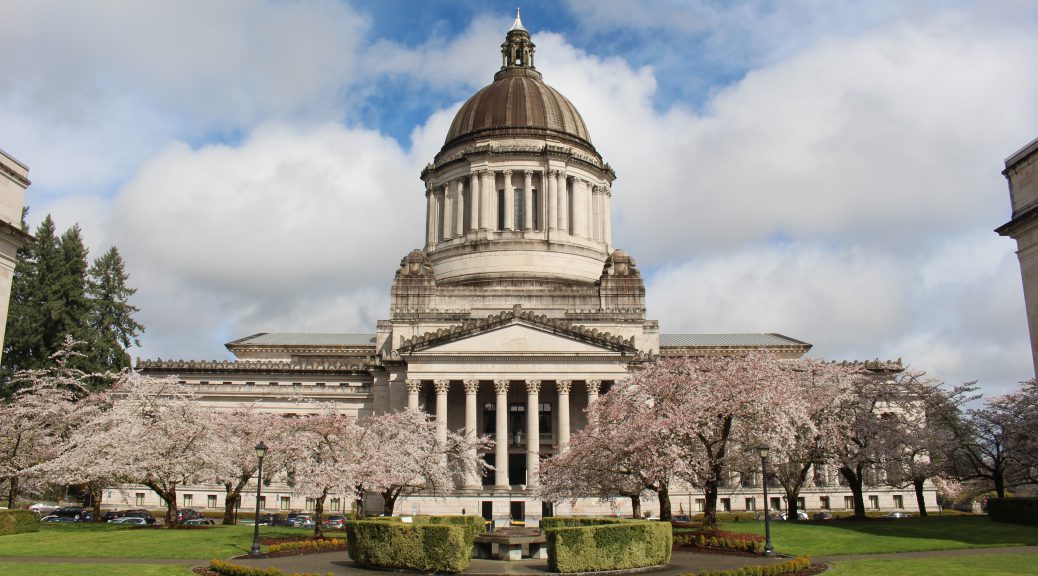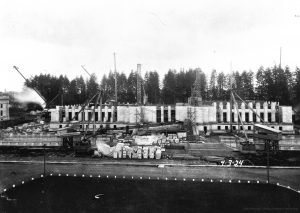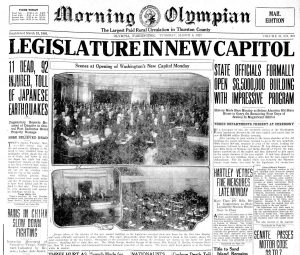
Archives Spotlight: The Legislative Building turns 90
In the quiet of the post-Legislative session interim period, the 90th anniversary of the Washington Capitol‘s opening to the public passed without a formal observance on March 28.
Perhaps that was fitting. The Legislative Building went without a grand opening party back in 1928 because of a political dispute over the perceived largesse of building and furnishing a $7 million government building.
The Legislative Building was constructed over much of the 1920s. Architects Walter Wilder and Harry White, whose plan beat out 37 other proposals, sent the State Capitol Commission detailed plans in 1920 that revised earlier layouts going back to 1911. Officials broke ground in 1922.

At left is a view of the Capitol construction site on today’s date in April 1924. A year later, the building’s iconic dome was beginning to take shape.
The completed building’s masonry dome stands 287 feet above ground level, and it’s still the fifth-highest masonry dome in the world. Legislative records say the dome’s construction required 15,400 tons of stone, brick, and concrete.
After the building was upright but unfinished, legislators convened inside it on March 7, 1927, for the last four days of the year’s session. The bathrooms weren’t finished and the ornamental bronze doors hadn’t been installed, but the building was in use.
The 1927 Journal of the House of Representatives called the Legislative Building “in reality a gift from the federal government.” When admitted to the Union, the Journal says, Washington state was allocated 132,000 acres of land that could be sold only to fund construction of buildings at the capital.
The price tag, however, drew the wrath of a new and frugal-minded governor.
Gov. Roland E. Hartley took office in 1926, well into the Capitol’s construction. He lambasted the “monument to extravagance in architectural design” he saw rising above Olympia. A HistoryLink.org essay describes how even the $47.50 spittoons (that’s the equivalent of $691.64 in 2018) to be used in the building drew Hartley’s ire.
Hartley accused the Capitol Committee of “a wild orgy of extravagance” in buying furniture and vetoed the $10,000 budget item for the building’s grand opening.
When state executives moved into Legislative Building offices March 28, 1928, and the building went into permanent public use, Hartley told reporters that the event “brings no joy to the heart of the taxpayer.” He added that he hoped it would deter “future extravagance on the part of those in whose hands the business affairs of the state are entrusted.”
Nine decades later, many of the furnishings Hartley criticized are still in regular use. The stately dome required repair and strengthening after the earthquakes of 1949, 1965, and 2001, along with other renovation and repair over the years.
The work to maintain the grandeur remains ongoing. Every few years, the moss buildup on the sandstone dome — particularly on the northward, Puget Sound-facing side — requires a thorough cleaning. A bill filed late in the 2018 Legislative session contemplated potential “adverse effects of the capitol dome’s grey toupee” on state workers.
The bill didn’t pass, but the year’s supplemental capital budget includes $3.4 million to get the moss scrubbed away, as it was in 2004 to help finish earthquake repairs and again in 2012.

